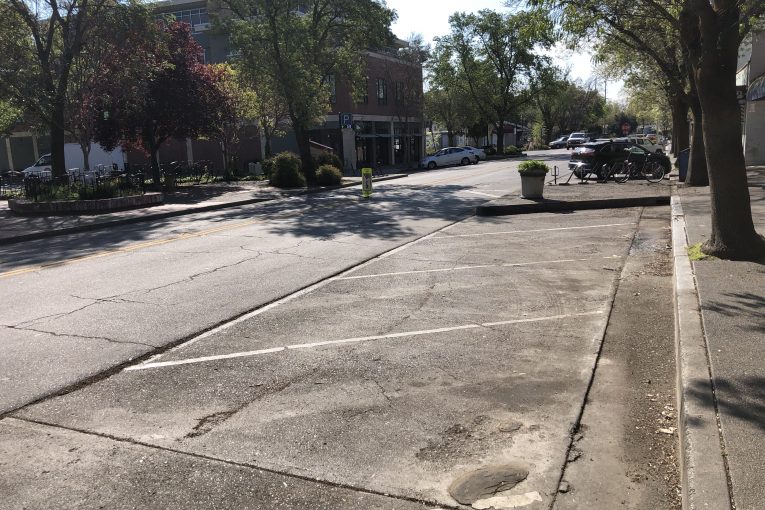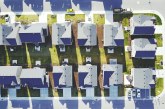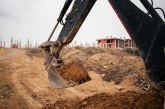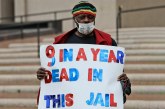

The first death in Yolo County occurred yesterday—the county per policy is not releasing a whole lot of information, but we do know that the fatality occurred “in an older adult with underlying chronic health problems.” The individual was the 6th confirmed case, but the county is not releasing much else including location of the victim.
One official told me, however, that the overall risk is “throughout the county” and it was a “community transmission,” meaning “there was not a specific unique place or situation.”
The current numbers in California are 1802 cases with 35 deaths, according to the LA Times. The number at press time was 33,276 confirmed in the US and 417 deaths. Worldwide that number is 337,091 with over 14,600 deaths.
There is perhaps some good news here and some bad news.
The good news that California’s rate is fairly low in terms of cases—perhaps owing to the quick response from the local areas and ultimately the governor to issue a stay-in-place order.
The bad news is that the rate of spread in the US continues to increase logarithmically. Italy, which is harder hit, is finally starting to see its rate of increase go down. But the total number of cases on Thursday in the US was less than 15,000—now it has more than doubled to 33,000.
The NY Times wrote late last week, “on a logarithmic scale, it is instantly apparent that the number of Americans becoming infected continues to double every three days or so. That indicates that the limited measures taken until recently did not sever social contact enough to slow the spreading.”
But some warn that, while the graphical comparisons are helpful, they are misleading. One big thing that the graphics don’t take into account—scale or incidence rates.
Italy has a population of 62 million while the US has a population of 330 million.
Dr. Lucina Suarez, an epidemiologist in Austin, Texas, explained, “These comparisons are always problematic since they are based on counts and not incidence rates.” She continued, “While giving a  sense of rapid rise in cases, it would be more valid if based on the same case definition — for example, mild versus severe cases — and knowing the criteria of who is tested and who is not.”
sense of rapid rise in cases, it would be more valid if based on the same case definition — for example, mild versus severe cases — and knowing the criteria of who is tested and who is not.”
But there is another danger here—the US numbers “are probably under-counted currently because testing is not very available here.”
But, while California at least appears to have slowed the spread with their early measures, New York is exploding.
The Times reports, “New York City and its suburbs account for roughly 5 percent of global cases, forcing officials to take urgent steps to stem the outbreak.”
The rapid increase means that resources are thin.
The Times writes, “All told, more than 15,000 people in New York State have tested positive, with the vast majority in the New York City region. That is about half of the cases in the United States.”
That is ten times the amount of cases as California for a population half the size.
Now the really bad news. The New York Times has an excellent piece that lays out the scientific assessment of the virus and its weaknesses, but also the extreme measures that it will take to contain prior to the advent of a vaccine that most believe is more than a year away.
“There is a chance to stop the coronavirus. This contagion has a weakness,” the Times writes.
The big finding is the coronavirus “more often infects clusters”—they don’t know why, although we can probably guess, but the scientists believe we can “contain clusters.”
Dr. David L. Heymann, who chairs an expert panel advising the World Health Organization on emergencies, said, “You need to identify and stop discrete outbreaks, and then do rigorous contact tracing.”
But we don’t have the ability resources to do this.
As they note: “But doing so takes intelligent, rapidly adaptive work by health officials, and near-total cooperation from the populace. Containment becomes realistic only when Americans realize that working together is the only way to protect themselves and their loved ones.”
They add: “Americans must be persuaded to stay home, they said, and a system put in place to isolate the infected and care for them outside the home. Travel restrictions should be extended, they said; productions of masks and ventilators must be accelerated, and testing problems must be resolved.”
The problem of course is that such tactics creating forced isolations have produced “divided reactions,” with some complying and some rebelling.
As they put it, “It was not at all clear that a nation so fundamentally committed to individual liberty and distrustful of government could learn to adapt to many of these measures, especially those that smack of state compulsion.”
But here is another critical point.
They write: “Many experts, some of whom are international civil servants, declined to speak on the record for fear of offending the president. But they were united in the opinion that politicians must step aside and let scientists both lead the effort to contain the virus and explain to Americans what must be done.”
In some ways, we have seen this happen at a more local level—in places like New York, Ohio, Washington and California.
The good news: “If it were possible to wave a magic wand and make all Americans freeze in place for 14 days while sitting six feet apart, epidemiologists say, the whole epidemic would sputter to a halt.”
That means extreme social distancing. And some studies have shown that six feet is not far enough, it needs to be more like 15—but right now we would settle for six.
California is going to have to consider two possible additional steps to shut down this infection, and right now California has to be considered a success story—just look at the comparison to New York or Washington.
One is that we may have to do checkpoints to limit where people go. The other is that the borders of the state could be shut down to prevent new cases from coming in after we have slowed the rate of growth in the state.
We will see what this week brings.
—David M. Greenwald reporting







Maybe all travel in and out of New York and Washington should be banned?
They apparently said something on the news that their might be a two week overall stay in place blanket order
It might be time to bite the bullet, a two week stay in place for the entire nation and keep the international travel bans in order until things look better. Summer will be here soon, we still don’t know if the heat will suppress the virus. Cross your fingers.
https://papers.ssrn.com/sol3/papers.cfm?abstract_id=3551767
Hopefully, “low humidity” and high very high temperatures will help out in the semi-desert that comprises much of California (and all of the southwest U.S.). I wouldn’t be surprised.
That’s encouraging.
BTW, it looks like Britain’s alternative path didn’t work: “Britain became the latest country to order people to stay indoors to slow the spread of the coronavirus. Prime Minister Boris Johnson said in a video posted on Twitter, allowing a few exceptions for shopping, exercising or seeking medical help.”
Replace “logarithmically” with “exponentially”. The former is the slowest increasing function, the latter is the fastest increasing function. I wish it was logarithmic.
One of the analyses use logarithm to determine the trajectory of the increase of cases
A logarithmic scale graph is used to plot exponential increases.
Therefore the sentence: “The bad news is that the rate of spread in the US continues to increase logarithmically.”
Should be: “The bad news is that the rate of spread in the US continues to increase exponentially.”
That was what Joseph meant.
“we still don’t know if the heat will suppress the virus. Cross your fingers.”
Yes, by all means, cross your fingers, whistle as you pass the graveyard and put sheep’s blood on your door. Meanwhile in high summer, cases are on the grow in Argentina, Australia, Brazil, Chile, Peru, South Africa, Singapore, Malaysia, etc. I’ve left out a few, but perhaps you get the point: hope in one hand; crap in the other and see which one fills up first.
I think hope is essential for human well being. I also believe that humans can affect our own destinies. So while I wish hope for all, I want it to start with the hope that all of us will abide by the recommended social isolation. I hope we all stay home, and that it has the desired effect.
One more hope. Please do not hoard. Do not demand antivirals, antimalarials or unproven antibiotics. These should be reserved for those who have a proven need for these specific drugs, not for those who have heard they maybe helpful.
Amen…
“I think hope is essential for human well being.”
Hope yes, mindless “happy talk” no.
While you are aware of the side effects and risks of Chloroquine the masses are not.
https://www.npr.org/sections/coronavirus-live-updates/2020/03/24/820512107/man-dies-woman-hospitalized-after-taking-form-of-chloroquine-to-prevent-covid-19
We are nowhere near the peak of the infection curve in the USA. Resolved cases in the USA show about a 14% mortality rate. The supply chain is broken. The education system is shutdown. There ain’t much visible light in this tunnel and we’re nowhere near the end
Masses? One couple drank FISH TANK CLEANER which contained the ingredient chloroquine phosphate.
Candidates for the 2020 Darwin Award.
Both from Covid-19, and dumb (or, no) responses, there will be some ‘natural selection’ that will take place… all we can do is to mitigate the degree to which it will occur.
Some people will just come out of this with acquired immunity… others will suffer, and come out of this with acquired immunity… others will die. Those are straight facts.
Yes Bill, unbelievable, that would be like someone being told to drink more water so they drink bleach because an ingredient is water.
Funny tho’… works the other way around, too… pure sodium (Na) is toxic. As is chlorine (Cl). NaCl is somewhat essential.
There are apparently differences between hydro-chloroquine, chloroquine, and (obviously) chloroquine phosphate. A little knowledge can be dangerous. As can an error in appropriate/effective dosage… think Goldilocks…
error…. should have read, “hydroxy-chloroquine”